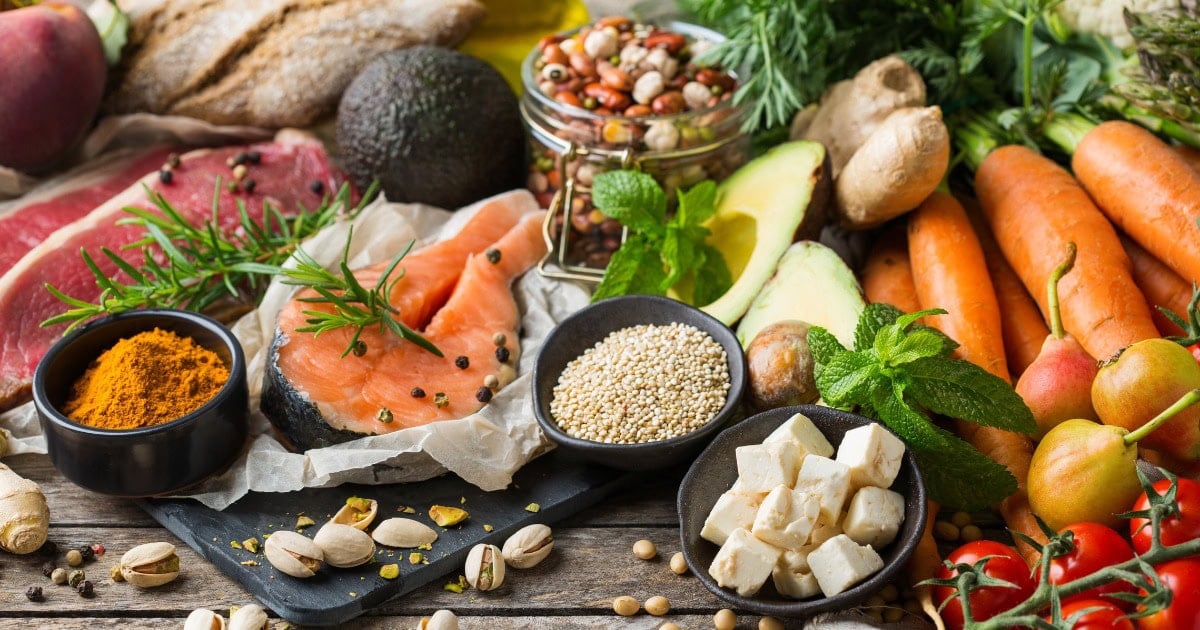This post may contain affiliate links. Please read our disclosure.
Managing diabetes is challenging enough without having to figure out which “diet” is best.
While carb counting is a common approach, there is no one-size-fits-all “diabetic diet” — at least, one that works for everyone.
In fact, there are many different diets, or eating plans that may be suitable for a person with diabetes. Each one is a tool in the toolbox that can help manage diabetes.
One option to consider is the flexitarian diet or eating plan. This plan takes a more moderate approach to meal planning, as it incorporates all food groups and doesn’t mandate completely eliminating foods.

What is the flexitarian diet?
A flexitarian diet (eating plan) is, as the name implies, a flexible approach to eating that primarily emphasizes plant-based foods while still allowing for the occasional burger or steak and other animal foods.
The term “flexitarian” (a combination of “flexible” and “vegetarian”) was first introduced more than a decade ago by registered dietitian Dawn Jackson Blatner, RD, LDN, in her 2009 book, The Flexitarian Diet: The Mostly Vegetarian Way to Lose Weight, Be Healthier, Prevent Disease and Add Years to Your Life.
This eating plan is also called a semi-vegetarian pattern. While the main focus is on fruits, vegetables, whole grains, legumes, nuts, and seeds, there’s still the opportunity to include meat, poultry, fish, eggs, and dairy foods.
In a nutshell, here are the guidelines for a flexitarian diet. Keep in mind that they are flexible and can be adapted to suit your own preferences and needs.
- Emphasize plant-based foods, including plant sources of protein.
- Include moderate amounts of animal foods.
- Focus on whole, minimally processed foods.
- Limit sweets, fried foods, and ultra-processed foods, such as luncheon meats, chicken nuggets, chips, and sweetened drinks.
- Be mindful of portions, especially portions of animal foods.
- Aim to eat plant-based meals most days of the week.
According to Blatner, you should include moderate amounts of animal foods, tailored to your flexitarian level:
- Beginners are encouraged to eat up to 26 ounces of meat or poultry per week with two meatless days
- Advanced flexitarians should aim for no more than 18 ounces, skipping meat 3 to 4 days a week
- Experts might limit their intake to just 9 ounces by going meatless 5 or more days a week.
The main theme? Eat more plant foods and less meat. This approach allows for a more flexible and realistic way of eating.
Learn more about diabetes-friendly eating plans in: What Is the Best Diet for Type 2 Diabetes?
What do you eat on a flexitarian diet?
Here’s a rundown of just some of the foods that make up a healthy flexitarian eating plan geared toward a person with diabetes. Note that this is not an exhaustive list!
- Fruits: E.g., apples, berries, watermelon, cantaloupe, peaches, oranges, mango.
- Vegetables: E.g., red peppers, mushrooms, leafy greens, broccoli, cauliflower, zucchini, green beans, cucumber, cabbage, asparagus.
- Whole grains: E.g., farro, oats, quinoa, amaranth, buckwheat, barley, millet, bulgur, brown rice.
- Legumes: E.g., beans (black beans, kidney beans, chickpeas), lentils, peas, edamame, hummus.
- Nuts and seeds: E.g., almonds, walnuts, cashews, peanuts, pistachios, chia seeds, flaxseeds, pumpkin seeds, sunflower seeds, nut butters.
- Plant-based protein foods: E.g., beans, lentils, edamame, tofu, tempeh, seitan.
- Dairy and dairy alternatives: E.g., lower-fat milk, unsweetened plant milks, plain Greek yogurt, plain soy yogurt, cottage cheese, plant-based cheese.
- Eggs: Free-range or pasture-raised, if possible.
- Fish and seafood: E.g., fatty fish (such as salmon, mackerel, trout, tuna, sardines), shellfish.
- Poultry: E.g., skinless chicken and turkey (free-range or pasture-raised, if possible).
- Meat: E.g., lean cuts of beef and pork (grass-fed or pasture-raised, if possible).
- Fats: E.g., avocado, olive oil, nuts, nut butters, seeds.
- Herbs and spices: Use sodium-free herbs and spices for flavoring.
- Condiments: E.g., lower-sodium soy sauce, vinegar, salsa, mustard, nutritional yeast.
- Beverages: E.g., water, sparkling water, tea, coffee.
Aim to minimize these foods:
- Red meats and processed meats such as cold cuts, sausage, bacon, hot dogs.
- Fried foods, such as French fries, chicken nuggets, fried snack foods.
- Highly processed foods, such as chips, sugary cereals, pastries, candy, white bread.
- Sugary drinks, such as soda, fruit juice, energy drinks, flavored coffees.
- Added sugars found in sweetened yogurt, salad dressings, sauces, and ketchup.
- High-fat dairy foods, such as whole milk, cream, full-fat cheese, ice cream.
- Too much alcohol. If you drink alcohol, stick with up to one drink per day for women and up to two drinks per day for men.
Tips for making a flexitarian eating plan work for you
Here are some practical tips for making this plan work for you.
Ease into it.
Start off slowly and build from there. The first step is to increase your intake of vegetables at each meal until you’re eating at least 2½ cups of vegetables daily.
Not sure how to add veggies to breakfast? Add some tomatoes and peppers to your omelet, whip up a veggie smoothie, or add grated carrots or spinach to your oatmeal.
And why not try a salad for breakfast, along with a plant protein food, such as beans or tofu?
Plan ahead.
Any eating plan is easier when you plan. Think about what you’ll have for meals for the week, and from there build out your shopping list. Decide which days you’ll have meat, chicken, or fish at your meals, or when you might have pizza or dessert.
Use the plate method as a guide.
Instead of a steak or chicken breast taking up half of your plate, trim it down so that vegetables fill up half the plate. Also make room for a whole grain, such as quinoa or brown rice. Add a piece of fruit, too. Aim for a variety of colors and textures.
Carb concerns.
If you’re worried about carbs from starchy foods, such as grains, potatoes, or pasta, swap them for lower-carb veggies. Or eat a small portion of carb foods and load up on vegetables.
Experiment with different foods.
Make a point to, say, try a new grain or different vegetables. Maybe give tofu a try! There are a lot of tasty and healthy foods out there. Look for new recipes from cookbooks, websites, or recipe apps.
Stock up on plant-based staples.
Keep your cupboards and fridge stocked with beans, lentils, whole grains, nuts, nut butters, seeds, fruits, and vegetables.
Meal prep.
Cook grains, beans, lentils, and veggies ahead of time. You can even freeze them for future use.
Monitor blood sugars.
It may seem tedious, but as you get started with your new eating plan, it really helps to check your blood sugars before and 2 hours after meals, at least for a while.
If you use CGM (continuous glucose monitoring), take note of your after-meal glucose levels as well as your time in range (TIR). Doing this can help you see first-hand how your foods and meals are impacting your glucose levels, as well as if and where you might need to make some adjustments.
If, despite the above tips, you are feeling overwhelmed or have more questions about a flexitarian eating plan, talk to a dietitian. They can give you more structure (for example, carb goals), if that’s what you need, as well as point you in the direction for meal prep and recipe ideas.
In addition, a dietitian can help you understand your glucose patterns and make tweaks to your food choices if your blood sugars are running too high or too low.
It’s also a good idea to let your healthcare provider know if you start on a flexitarian eating plan — or any new eating plan, for that matter. Changes to your food choices, portions, and eating habits could likely affect your blood sugars. This may result in a need for a change in your diabetes medication (if you take any).
Why might a flexitarian diet be ideal for some people with diabetes?
You might be scratching your head, thinking that there’s no way a flexitarian diet could work for a person with diabetes. After all, it does include foods that contain carbohydrates (carbs) and carbs are bad for diabetes, right? Not necessarily.
The flexitarian eating plan emphasizes plant-based foods that are rich in fiber, vitamins, minerals, and antioxidants.
Consuming a variety of fruits, vegetables, whole grains, legumes, nuts, and seeds has been shown to promote insulin sensitivity and reduce insulin resistance (a key marker of type 2 diabetes). This means that the cells in the body are more responsive to the effects of insulin. End result: More glucose moves from the blood into cells to be used for fuel.
Also, by eating more plant foods, your intake of fiber increases. Fiber (which is only found in plant foods) can help reduce blood glucose spikes after eating. Healthy gut bacteria ferment fiber in the intestines to produce short-chain fatty acids which, in turn, improves insulin sensitivity.
And don’t forget that dietary fiber promotes satiety (feelings of fullness) and assists with weight loss, which can also reduce insulin resistance.
Plant-based diets for people with diabetes have been shown to reduce chronic inflammation. Research shows that chronic diseases, including type 2 diabetes, heart disease, obesity, sleep apnea, and many other health conditions stem from inflammation. Plant foods are believed to be anti-inflammatory, as they are rich in antioxidants, fiber, and healthy fats.
Animal foods, such as red meat, processed meats, and high-fat dairy foods, as well as refined carb foods are pro-inflammatory, meaning that they are linked with inflammatory markers in the body.
Eating fewer animal foods can also improve heart health and reduce the risk of heart disease, including heart attack, the leading cause of death in people who have diabetes.
Reducing your intake of high-fat animal foods, such as red meat, chicken and pork skin, processed meat, and whole-milk dairy products helps to lower saturated fat and trans fats. The American Heart Association recommends consuming no more than 5 to 6 percent of your calories from saturated fat.
Other benefits of a lower total fat, and especially lower saturated fat, intake include improved insulin sensitivity and a decrease in hemoglobin A1c levels (a measure of glucose control over the previous 2 to 3 months).
What are the risks and benefits of a flexitarian diet?
Every eating plan has its benefits and risks, or pros and cons. Remember, no specific eating plan will work for every person. For this reason, it’s important to understand the benefits and risks, or drawbacks of this and every diet that you are thinking about trying.
Benefits:
- A lower risk of heart disease, lower blood pressure, improved cholesterol, better blood sugars and A1c, better weight management, and a lower risk of some cancers.
- A lower risk of developing type 2 diabetes, which means this approach can be helpful for people with prediabetes.
- A lower risk of nutrient deficiencies because this eating plan includes both plant and animal foods. Overall, a flexitarian diet is a well-balanced eating plan that has evidence to support its benefits.
- Easily adaptable to personal food preferences, as well as to dietary restrictions, such as gluten, lactose, and food allergies.
- Easier to adhere to than more rigid eating plans, which means a greater likelihood of staying with this eating plan longer-term. You can eat at a friend’s house or go out to a restaurant and still stay within the guidelines.
- Family-friendly, because no foods are completely off-limits.
- Budget-friendly, because this approach doesn’t require special foods or meal replacements, which can be costly. You can choose foods that fit your food budget and buy what you need from your regular grocery store.
Risks:
- Possible risk of some nutrient deficiencies if animal foods are significantly restricted. Pay attention to getting enough protein, vitamin B12, iron, calcium, zinc, and omega-3 fatty acids. A registered dietitian nutritionist (RDN) can help if you’re concerned about getting enough of certain nutrients with this eating plan.
- May require some getting used to (which is true for any change in your eating plan). If you’re used to eating more meat or other animal foods, it can take some time to adjust to eating meat less often, as well as eating smaller portions.
- Potential for making unhealthy choices. This is not a rigid diet that gives you a list of foods to eat and foods to avoid. Without guidance, you could find yourself eating less healthy, more processed plant-based foods, such as French fries, refined carbs (e.g., white bread and white rice), and sugary snacks.
- A challenge managing blood sugars. While a flexitarian plan can help you improve your diabetes management, too large portions of carb foods, as well as too many refined carb foods could lead to higher blood sugars. Paying attention to your carb intake and monitoring your blood sugars often is important so that you can see how various foods and portions impact your diabetes.
Embracing flexibility
A flexitarian eating plan could be a plan that fits with your eating habits and food preferences. Because it’s not overly rigid and allows a wide variety of foods, you may find that this type of plan is more flexible and easier to stick with, compared to other, more structured plans that can be more challenging to follow.
Following a flexitarian plan should not feel restrictive or make you feel like you’re missing out. But realize, too, that you’ll need to pay attention to your glucose levels and work with your healthcare team to adjust your diabetes treatment plan, as needed.
Explore some of the delicious flexitarian-friendly recipes in our Recipe Index. Did you find this article helpful? Click Yes or No below to let us know!





Donald
First of all let me say that I enjoy your articles very much. You have much to share to the diabetic world. Anyway have a few questions. Been a while since I have been on here. Anyway I am 80yrs young and have type 2 diabetes. I also have kidney disease and fatty liver. Kind of a mess I am. Anyway my question is or perhaps several questions in no order: I did look at your keto diet and wonder if having a lot of fat could or would be somewhat counterproductive to losing some weight and creating lower blood sugar levels? Since January of this yr I have either had several colds and coughs, the flu bug on a monthly basis. My blood sugars every time that I get sick go sky hi, like 250 one time, avg about 170-180. Not good. But some good news for the past 3 wks or so my bloods have been much better, somewhere around the 140-150 levels. My lastest A1c just recently was 8.9 also not good.
Anyway I do have a few more questions but getting late and perhaps I can respond with a few more in a earlier time of day.
Take care and please be safe,
Donald
Christel Oerum, MS
You can lose weight on Keto, but you can also gain weight. Overall it will come down to your calorie balance. Some find that when they eat keto they don’t eat as much as a high-fat diet can be filling. I would encourage you to consult your medical team and discuss if a diet like that would work with your medical conditions. Just to be on the safe side.
Carrie Martin
Love this, I am finding eating this way I feel good. I don’t feel like I am missing out on anything. Eating keto all the time makes me feel to skinny, I’m working out and adding some extra carbs helps me feel better. I wish I had a 1/2 dose capability on my pen. Finally going to see endocrinologist in May after two years of ups and downs of being type2 or type1, finally was tired of trying all the pills and asked my Dr to test my pancreas and yes I’m just not quite making enough insulin, so type1 I am. Dr thinks pump would be beneficial because I am obsessed with keeping my numbers low. Thyroid issues for 30+ years.
I am kinda worried about a pump I’m not good with things hanging off me, and have the injections down for my eating.
Bless you all out there 💪🏼🙌🏼
R
This article nails it!
Understanding diet and each individuals needs is vital. I have done all the different diets and fortunately I am not overweight. But I have other needs like fiber intake (both solvable and insolvable) that I need for good gut health. That means some carbs, but important to measure them. Portion control thru out is very important. Balance. Actively following a self disciplined diet. Can’t believe how when you get it all figured out, ie. diet, one feels Great.
Health class in high school and college both should be required! If our society FELT better, we would all be happier and far better off mentally and physically!
Glenn Nordal
I’m one of these rare cases where the doctors yes doctors seem to think I’m a 1.5 diabetic , I take long and fast acting insulin daily , fast acting , multiple times a day yet my blood sugar is always high . I don’t drink , smoke or do drugs and was a letter carrier for 36 years , now at 57 and retired I still walk lots but keep gaining weight , seems no matter what I eat I gain weight , I have basically cut carbs right out of my diet yet i still struggle with high blood sugar , any answers or suggestions for someone in my situation , the doctors don’t seem to know other than telling me to take more insulin , to me it seems like the insulin doesn’t always work , I’m even on metformin and still have high levels constantly when i wake up , I take 60 units of long at night , and 12 of fast whenever I eat , sometimes with touch ups to try and keep my blood sugar below 10 ????????????
Ginger Vieira
Hi Glenn! Something is definitely not right and I would highly recommend first of all that you reach out to Gary Scheiner, MS, CDE at IntegratedDiabetes.com. Your current healthcare team isn’t looking at the bigger picture.
Something else to consider is the type of long-acting insulin you’re taking. Some people don’t respond as well to one versus another. For instance, when I take Levemir, my blood sugars act like I’m taking saline unless I took 4 or 5 times my Lantus dose.
Everyone is different.
Regardless, something isn’t right and you need some new experts and new opinions. Gary Scheiner is one of the BEST CDEs on the planet and worth every penny. He works with people across the globe and has seen it all. Schedule with him!
rahul
Hi , I just read the article on a flexiterian diet . Was wondering with the next to no carb veggies I probably wouldn’t need fast acting insulin..Should I always have 1 higher carb veg?? Or if I did need a little insulin how do you work out how much you would need with the lower carb veg ? I’ve been wanting to try but not sure if most of the time I can not have the quick acting insulin, then if I want something with say 3 to 4 servings of carbs if it would be ok to use insulin ..
Thank you
Ginger Vieira
Hi there!
You will absolutely likely need a small dose of insulin with low-carb vegetables. Broccoli, for example, can easily add up to 10 grams of carbs. Personally, I would need .5 to 1 unit of fast-acting insulin if I ate a decent serving of most low-carb vegetables. If I’m just eating a few carrots, I might not need any insulin. If you’re eating low-carb veggies with a protein (like chicken or steak), you’ll likely find you need a few units of insulin.
It really comes down to trial and error. I suggest using CalorieKing.com to look up the carb-content of low-carb vegetables to help you get a better idea of how many carbs you’re eating. And err on the side of caution when dosing your insulin. If you have a high blood sugar 2 hours after eating, then you know you likely needed more insulin with that particular vegetable and that serving size.
Check your blood sugar often, take good notes, and continue to research! 🙂
zamin
In all out concurrence with Teresa’s note above. Despite everything we need quick acting insulin for a wide range of suppers, yet a feast of cheddar and broccoli (for instance) is going to require just a “smidge” of insulin contrasted with eating potatoes or rice. Fat and protein both require a nearness of insulin so as to be utilized for fuel.
Regarding how much insulin you take for 3 or 4 servings, it would rely upon what you’re eating, what your specialist’s insulin-to-starch proportion is for your body, and what your glucose is the point at which you plunk down to eat that feast.
I trust that is useful. Dosing insulin for nourishment is an unpredictable game!
Chitra Pandey
Your blog is so nice and full of information.I really enjoying your blog
Charlene Johnson
Hi , I just read the article on a flexiterian diet . Was wondering with the next to no carb veggies I probably wouldn’t need fast acting insulin..Should I always have 1 higher carb veg?? Or if I did need a little insulin how do you work out how much you would need with the lower carb veg ? I’ve been wanting to try but not sure if most of the time I can not have the quick acting insulin, then if I want something with say 3 to 4 servings of carbs if it would be ok to use insulin ..
Thank you ?
Teresa
You should still dose with fast acting insulin based on the ratio of carb/insulin you are currently using. My carb/insulin ration is 1 unit per 10 carbs.
Veggies still have carbs.
Ginger Vieira
In total agreement with Teresa’s note above. We still need fast-acting insulin for all types of meals, but a meal of cheese and broccoli (for example) is going to need only a “smidge” of insulin compared to eating potatoes or rice. Fat and protein both require a presence of insulin in order to be used for fuel.
In terms of how much insulin you take for 3 or 4 servings, it would depend on what you’re eating, what your doctor’s insulin-to-carbohydrate ratio is for your body, and what your blood sugar is when you sit down to eat that meal.
I hope that’s helpful. Dosing insulin for food is a complex game!